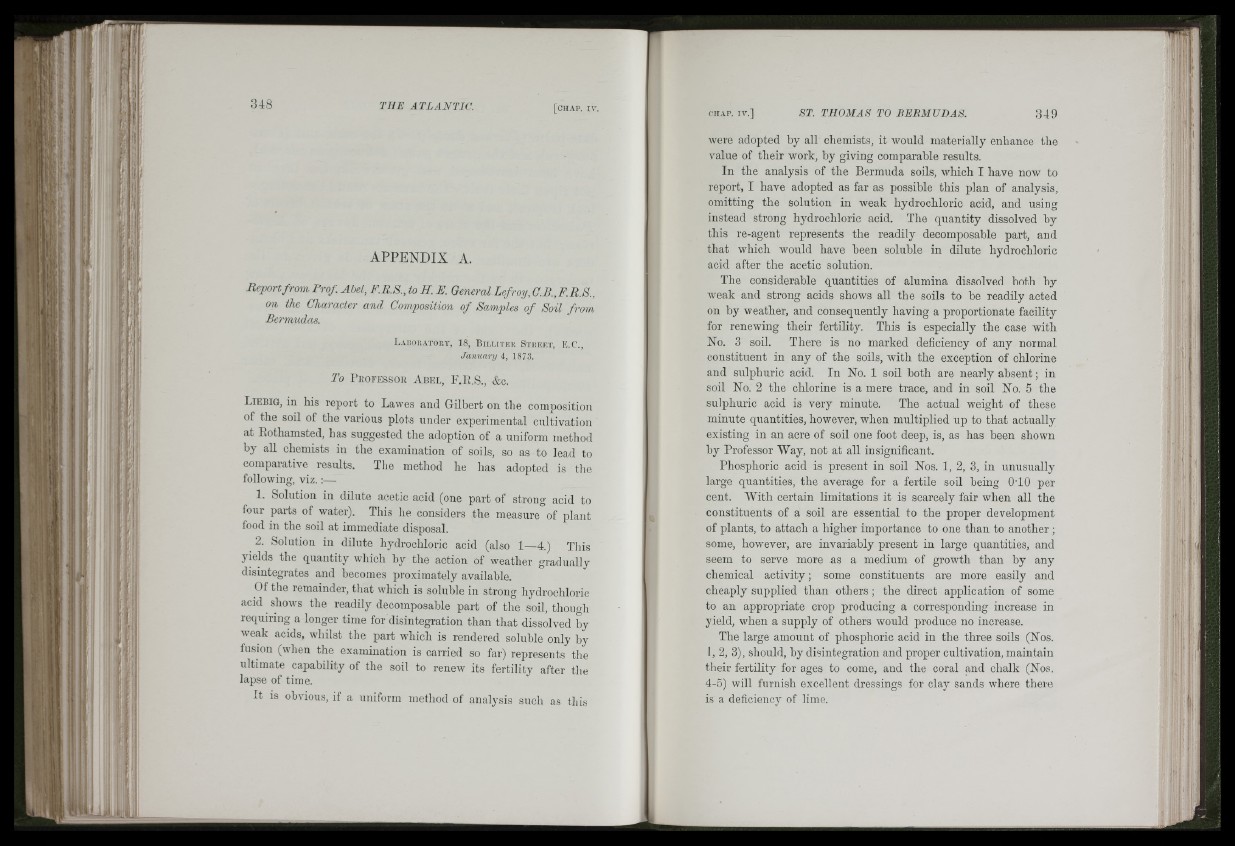
APPENDIX A.
Report from Prof. Abel, F.R.S., to H. E. Oencral Lefroy, C.B.,F.R.S.,
on the Character and Composition of Samples of Soil from
Benmidas.
L a h o r a to ry , 18, Bii.i.itku S tu e e t , E.C.,
January i, 1873.
To I ’KOFESSOR A b e l , F.ES., &c.
L i e b i g , in his report to Lawes and Gilbert on the composition
of the soil of the various plots under experimental cultivation
at Eothamsted, has suggested the adoption of a uniform method
by all chemists in the examination of soils, so as to lead to
comparative results. The method he has adopted is the
following, viz.:—
1. Solution in dilute acetic acid (one part of strong acid to
four parts of water). This he considers the measure of plant
food in the soil at immediate disposal.
^ 2. Solution in dilute hydrochloric acid (also 1—4.) This
yields the quantity which by the action of weather gradually
disintegrates and becomes pi'oxirnately available.
Of the remainder, that which is soluble in strong hydrochloric
acid ^ shows the readily decomposable part of the soil, though
requiring a longer time for disintegration than that dissohmd by
weak acids, whilst the part which is rendered soluble only by
fusion (when the examination is carried so far) represents the
ultimate capability of the soil to renew its fertility after the
lapse of time.
It is obvious, if a uniform method of analysis such as this
were adopted by all chemists, it would materially enhance the
value of their work, by giving comparable results.
In the analysis of the Bermuda soils, which I have now to
report, I have adopted as far as possible this plan of analysis,
omitting the solution in weak hydrochloric acid, and using
instead strong hydrochloric acid. The quantity dissolved by
this re-agent represents the readily decomposable part, and
that which would have been soluble in dilute hydrochloric
acid after the acetic solution.
The considerable quantities of alumina dissolved both by
weak and strong acids shows all the soils to he readily acted
on by weather, and consequently having a proportionate facility
for renewing their fertility. This is especially the case with
No. 3 soil. There is no marked deficiency of any normal
constituent in any of the soils, with the exception of chlorine
and sulphuric acid. In No. 1 soil both are nearly absent; in
soil No. 2 the chlorine is a mere trace, and in soil No. 5 the
sulphuric acid is very minute. The actual weight of these
minute quantities, however, when multiplied up to that actually
existing in an acre of soil one foot deep, is, as has been shown
hy Professor Way, not at all insignificant.
Phosphoric acid is present in soil Nos. 1, 2, 3, in unusually
large quantities, the average for a fertile soil being OTO per
cent. With certain limitations it is scarcely fair when all the
constituents of a soil are essential to the proper development
of plants, to attach a higher importance to one than to another;
some, however, are invariably present in large quantities, and
seem to serve more as a medium of growth than by any
chemical activity; some constituents are more easily and
cheaply supplied than others; the direct application of some
to an appropriate crop producing a corresponding increase in
yield, when a supply of others would produce no increase.
The large amount of phosphoric acid in the three soils (Nos.
1, 2, 3), should, by disintegration and proper cultivation, maintain
their fertility for ages to come, and the coral and chalk (Nos.
4-5) will furnish excellent dressings for clay sands where there
is a deficiency of lime.